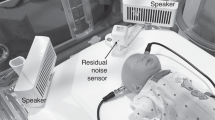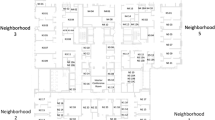Abstract
Recommended standards for the acoustic environment of the newborn intensive care unit (NICU) have become more protective over time based on research about the deleterious effects of noise and distraction on infants and adults, and on experience in successfully designing and building quiet hospital nurseries. The 2006 Recommended Standards for Newborn ICU Design include an operating, hourly Leq of 45 dBA, hourly L10 of 50 dBA and Lmax of 65 dBA. Rationales are presented for supporting these levels with noise criterion NC-25 for mechanical systems and thorough use of sound containment and absorption strategies. Involvement of an acoustical engineer throughout the design, build and post-construction validation process will help to ensure that objectives are met. Clinicians are reminded that conscientious self-management in maintaining quiet and acoustic privacy continues to be necessary even in NICUs built for quiet.
This is a preview of subscription content, access via your institution
Access options
Subscribe to this journal
Receive 12 print issues and online access
$259.00 per year
only $21.58 per issue
Buy this article
- Purchase on Springer Link
- Instant access to full article PDF
Prices may be subject to local taxes which are calculated during checkout
Similar content being viewed by others
References
Gray L, Philbin MK . Effects of the neonatal intensive care unit on auditory attention and distraction. Clin Perinatol 2004; 31 (2): 243–260.
Philbin MK . Planning the acoustic environment of a neonatal intensive care unit. Clin Perinatol 2004; 31 (2): 331–352.
Evans JB, Philbin MK . Facility and operations planning for quiet hospital nurseries. J Perinatol 2000; 20 (8): S105–S112.
Graven SN, Bowen Jr FW, Brooten D, Eaton A, Graven MN, Hack M et al. The high-risk infant environment. Part 1. The role of the neonatal intensive care unit in the outcome of high-risk infants. J Perinatol 1992; 12 (2): 164–172.
Philbin MK (ed). The influence of auditory experience on the fetus, newborn, and preterm infant: report of the sound study group of the national resource center. The physical and developmental environment of the high risk infant. J Perinatology 2000; 20 (8): S1–S142.
Philbin MK, Robertson A, Hall III JW . Recommended permissible noise criteria for occupied, newly constructed or renovated hospital nurseries. J Perinatology 1999; 19 (8): 559–563.
Committee to establish Recommended Standards for Newborn ICU Design. Recommended Standards for Newborn ICU Design. South Bend, IN: Memorial Hospital of South Bend, 1999.
Philbin MK . The influence of auditory experience on the behavior of preterm newborns. J Perinatol 2000; 20: S77–S87.
The American Institute of Architects Academy of Architecture for Health. Guidelines for Design and Construction of Hospital and Health Care Facilities. American Institute of Architects: Washington, DC, 2001, Chapter 7:A7.3.E6:28.
Facilities Guidelines Institute and The AIA Academy of Architecture for Heath Guidelines for Design and Construction of Health Care Facilities, Washington, DC: The American Institute of Architects Academy of Architecture for Health, 2006.
Author information
Authors and Affiliations
Corresponding author
Rights and permissions
About this article
This article is cited by
-
Noise Reduction Based on Training Intervention and Using Visual Signs in Neonatal Intensive Care Units (NICUs)
Acoustics Australia (2020)
-
The characterization of noise levels in a neonatal intensive care unit and the implications for noise management
Journal of Environmental Health Science and Engineering (2014)
-
Infants born very preterm react to variations of the acoustic environment in their incubator from a minimum signal-to-noise ratio threshold of 5 to 10 dBA
Pediatric Research (2012)
-
Comparing sound measurements in the single-family room with open-unit design neonatal intensive care unit: the impact of equipment noise
Journal of Perinatology (2012)
-
The impact of a noise reduction quality improvement project upon sound levels in the open-unit-design neonatal intensive care unit
Journal of Perinatology (2010)



